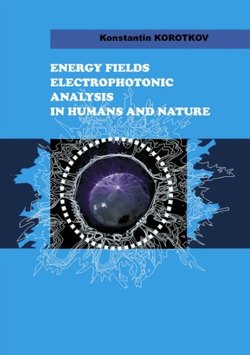Читать книгу Energy Fields Electrophotonic Analysis In Humans and Nature - Konstantin M.D. Korotkov - Страница 29
The influence of mental, emotional and spiritual processes on EPI/GDV images
ОглавлениеAn interesting aspect of EPI applications is the research into consciousness processes. Many years of experimentation have made it possible to identify bioelectrographic correlates of altered states of consciousness (ASC) [Bundzen et al, 2000; 2002]. These are particular states, which a person enters during meditation, mental training, religious ecstasy, or when under the influence of drugs, psychedelics or anesthesia. For many years we have been measuring Russian healers, Candamblier priests in Brazil, participants of the Ayahuasca ceremony in Peru [Korotkov, 2002, 2003], Chinese Qi-gong masters, and healers in Germany, the USA, and Slovenia [Measuring Energy Fields, 2004]. And almost all of these observations we obtain signs characteristic of ASC. Similar results, using the most diverse devices and methods, were obtained in the laboratories of different countries [Radin, 1997; Milton, 1996]. This shows that the processes of consciousness are apparent on the physiological processes measured by the EPI method.
We do not intend in this book to discuss the philosophical aspects of the process of researching consciousness. That could be the theme of an entirely separate, specialized book. Let us look simply at the opinions on which our work is based. We support the idea that consciousness is a category of a different space-time continuum which does not belong to the material world. These principles of working on consciousness are to a large extent modeled on the quantum mechanics paradigm, but clearly this is only a superficial analogy. We are still a long way from understanding the working mechanisms of consciousness, taking into account not only its individual manifestation in each person, but also its collective processes [Korotkov, 2001]. Human consciousness is a process of interaction between a person and a collective field, through which new ideas are formed, and the field is the place to which they return, making a contribution to the collective mind of humanity.
With physical devices we measure physical processes, i.e. processes of the material world. This is connected to biology as much as to physics and chemistry. That is why we can only measure the influence of consciousness on physiological or physical processes. This influence is conveyed along several channels, primarily through the cerebrum, which takes an active part in thought and emotion processes. The brain produces a cascade of chemical substances which influence physiological processes, and also the central nervous system models the work of the autonomic nervous system [Wisneski, Anderson, 2009].
We have already left behind the idea that the brain produces consciousness like the liver produces bile. The brain is better presented as a receptacle which reacts to the signals of the surrounding space, including signals from the collective field. Hairs can act as the antenna of these signals, as they react to the external field and transmit these signals to the cutaneous covering, possibly with some intensification. The numerous results of our experiments testify to this process with human hair [Vainshelboim et al, 2005].
The heart is another organ which takes part in the processes of consciousness. This is not merely a pump for blood, but an organ which regulates the blood flow and, accordingly, oxygen, in all areas of the human body. There is data showing that after a heart transplant, a person takes on many behavioral characteristics of the donor. So we can conclude that the heart, at least, has a memory, i.e. it takes part in consciousness processes.
The experimental observations measure the influence of consciousness on physiological processes. In this regard the EPI method is very sensitive, because it reacts to subtle changes in the working of the ANS. These sensitive measures make it possible to register subconscious and emotional processes.
Another method is the registration of the influence of human consciousness on physical sensors. One of the most recent is water, or specially constructed systems. Many experiments have proved that such an approach is highly effective [Science of Whole Person Healing, 2004].
Modern science has only just begun to research consciousness. Following the remarkable insights of Fechner, Helmholtz, Jung and Freud, a significant process was set in motion to study the brain’s neuron mechanisms, especially using modern methods of computer mapping. Yet we are still only in the early stages of the process of researching consciousness, and the most important thing at the moment is the set of experimental data. Their meta-analysis at a specific stage will provide an awareness of new concepts and lead us toward a new understanding.
